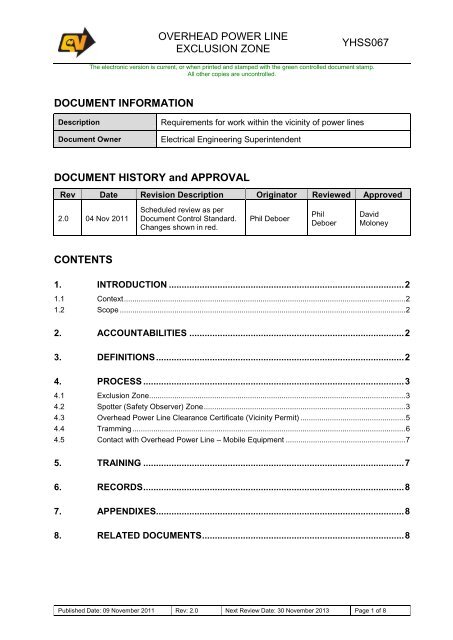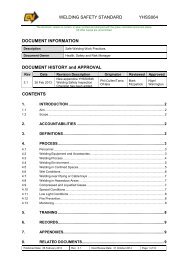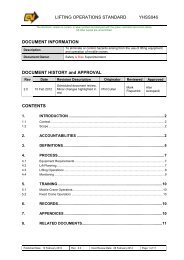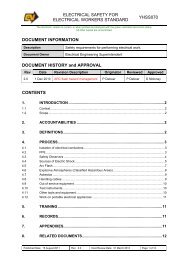OVERHEAD POWER LINE EXCLUSION ZONE ... - Queensland Nickel
OVERHEAD POWER LINE EXCLUSION ZONE ... - Queensland Nickel
OVERHEAD POWER LINE EXCLUSION ZONE ... - Queensland Nickel
Create successful ePaper yourself
Turn your PDF publications into a flip-book with our unique Google optimized e-Paper software.
<strong>OVERHEAD</strong> <strong>POWER</strong> <strong>LINE</strong><br />
<strong>EXCLUSION</strong> <strong>ZONE</strong><br />
YHSS067<br />
The electronic version is current, or when printed and stamped with the green controlled document stamp.<br />
All other copies are uncontrolled.<br />
DOCUMENT INFORMATION<br />
Description Requirements for work within the vicinity of power lines<br />
Document Owner Electrical Engineering Superintendent<br />
DOCUMENT HISTORY and APPROVAL<br />
Rev Date Revision Description Originator Reviewed Approved<br />
2.0 04 Nov 2011<br />
CONTENTS<br />
Scheduled review as per<br />
Document Control Standard.<br />
Changes shown in red.<br />
Phil Deboer<br />
Phil<br />
Deboer<br />
David<br />
Moloney<br />
1. INTRODUCTION ............................................................................................ 2<br />
1.1 Context ...................................................................................................................................... 2<br />
1.2 Scope ........................................................................................................................................ 2<br />
2. ACCOUNTABILITIES .................................................................................... 2<br />
3. DEFINITIONS ................................................................................................. 2<br />
4. PROCESS ...................................................................................................... 3<br />
4.1 Exclusion Zone.......................................................................................................................... 3<br />
4.2 Spotter (Safety Observer) Zone ................................................................................................ 3<br />
4.3 Overhead Power Line Clearance Certificate (Vicinity Permit) .................................................. 5<br />
4.4 Tramming .................................................................................................................................. 6<br />
4.5 Contact with Overhead Power Line – Mobile Equipment ......................................................... 7<br />
5. TRAINING ...................................................................................................... 7<br />
6. RECORDS ...................................................................................................... 8<br />
7. APPENDIXES................................................................................................. 8<br />
8. RELATED DOCUMENTS ............................................................................... 8<br />
Published Date: 09 November 2011 Rev: 2.0 Next Review Date: 30 November 2013 Page 1 of 8
<strong>OVERHEAD</strong> <strong>POWER</strong> <strong>LINE</strong><br />
<strong>EXCLUSION</strong> <strong>ZONE</strong><br />
YHSS067<br />
The electronic version is current, or when printed and stamped with the green controlled document stamp.<br />
All other copies are uncontrolled.<br />
1. INTRODUCTION<br />
1.1 Context<br />
Under the Electrical Safety Act (ESA) an Exclusion Zone is created around overhead<br />
power lines by observing the safe approach distance described within the ESA Code of<br />
Practice for “Working near Exposed Parts<br />
1.2 Scope<br />
This standard is applicable to either;<br />
� Any work or other activity in the vicinity of overhead power lines within the fenced<br />
area of <strong>Queensland</strong> <strong>Nickel</strong>, or,<br />
� Any activity under the control of <strong>Queensland</strong> <strong>Nickel</strong>, that may inadvertently<br />
encroach the exclusion zone around those power lines for any reason<br />
1.2.1 Electrical infrastructure<br />
Specific electrical infrastructure, affected by this standard is as follows:<br />
� 11kV overhead power lines supplying the 410 and 310 areas owned by<br />
<strong>Queensland</strong> <strong>Nickel</strong>.<br />
� 132kV, 66Kv and 11kV overhead power lines being part of the utility (Powerlink and<br />
Ergon) grid as situated within the fenced area the <strong>Queensland</strong> <strong>Nickel</strong> land<br />
boundary.<br />
� The 11kV Reactor situated within the 380 Primary Substation yard.<br />
� Other power lines outside <strong>Queensland</strong> <strong>Nickel</strong> that affects activities of <strong>Queensland</strong><br />
<strong>Nickel</strong> (eg Black River bore field 11kV Ergon power lines)<br />
� Low voltage powerlines, including insulated aerial conductors.<br />
The term “overhead power lines” as quoted in this standard includes the infrastructure<br />
listed in this section.<br />
1.2.2 Exclusions<br />
Any work that is likely to have an incursion into the approach limits of overhead power<br />
lines shall be subject to an authorised system of isolation and access, such as<br />
YHSS066 High Voltage Isolation and Access.<br />
Any activity that is not a controlled activity of <strong>Queensland</strong> <strong>Nickel</strong> in the vicinity of<br />
Powerlink and Ergon overhead power line crossings over Greenvale Street is not<br />
subject to this standard. In such cases, the entity in control of the activity is<br />
responsible for managing exclusion zone clearances in accordance with the Electrical<br />
Safety Act and Regulations.<br />
Electrical cables, other than aerial conductors, are outside the scope of this standard.<br />
2. ACCOUNTABILITIES<br />
� Electrical Engineering Superintendent<br />
o Responsibility for managing compliance with this procedure<br />
� All Personnel<br />
o Responsibility for compliance with this procedure<br />
3. DEFINITIONS<br />
TERM DEFINITION<br />
Published Date: 09 November 2011 Rev: 2.0 Next Review Date: 30 November 2013 Page 2 of 8
<strong>OVERHEAD</strong> <strong>POWER</strong> <strong>LINE</strong><br />
<strong>EXCLUSION</strong> <strong>ZONE</strong><br />
YHSS067<br />
The electronic version is current, or when printed and stamped with the green controlled document stamp.<br />
All other copies are uncontrolled.<br />
A nominated member of the work group who has signed onto<br />
Spotter<br />
the vicinity permit as the spotter to perform the duties of a<br />
spotter as prescribed within this procedure.<br />
4. PROCESS<br />
4.1 Exclusion Zone<br />
In order to fulfil the requirements of the Electrical Safety Act, an exclusion zone is<br />
created around power lines and other exposed electrical conductors, such as the 11kV<br />
reactor yard at the 380 Primary Substation yard.<br />
For the purpose of this standard, voltages up to and including 132kV Overhead<br />
Powerlines the exclusion zone for exposed conductors is 3000mm. The Electrical<br />
Safety Regulations may, for different situations, specify shorter exclusion zones less<br />
than the 3000mm prescribed by this standard. To use these shorter exclusion zones,<br />
written permission must be obtained from the Electrical Engineering Superintendent or<br />
his delegate.<br />
4.1.1 Mobile equipment within the Exclusion Zone<br />
A person shall not operate any mobile equipment or undertake work in situations<br />
where:<br />
� Any part of the mobile equipment e.g. cranes, forklifts, truck trays etc<br />
� A person working in the bucket of an elevating work platform (EWP);<br />
� Any hand tools or other equipment held by any person involved with the operation,<br />
or<br />
� The load being moved<br />
� Scaffolding, ladders etc are within the exclusion zone.<br />
Mobile equipment includes, but is not limited to:<br />
� Cranes, trucks, forklifts<br />
� Concrete placing booms,<br />
� Elevating work platforms,<br />
� Excavating equipment<br />
4.1.2 Work within the Exclusion Zone<br />
Where work can only be performed by entering the exclusion zone, such work shall be<br />
subject to YHSS066 High Voltage Isolation and Access. Work within the exclusion<br />
zone of live overhead power lines is not allowed.<br />
4.2 Spotter (Safety Observer) Zone<br />
The spotter zone concept is designed to encourage plant operators to locate their<br />
equipment away from the possibility of encroaching the exclusion zone; and when that<br />
is not possible, adopt other suitable precautions (refer to section 4.3 – Vicinity Permit)<br />
to prevent encroachment.<br />
A spotter shall be employed when a crane or plant is operating within the spotter zone.<br />
4.2.1 Extension of the spotter zone (more than 10 metres)<br />
Any plant or equipment is considered to be in the “Spotter Zone” when it could enter<br />
the exclusion zone of live electric lines during operation for any reason.. In such cases,<br />
the spotter zone could be extended in excess of 10 metres. Examples are:<br />
� Unrestrained crane jib or excavator boom of length greater than 10 metres.<br />
� Carried or suspended load that could inadvertently enter the exclusion zone.<br />
Published Date: 09 November 2011 Rev: 2.0 Next Review Date: 30 November 2013 Page 3 of 8
<strong>OVERHEAD</strong> <strong>POWER</strong> <strong>LINE</strong><br />
<strong>EXCLUSION</strong> <strong>ZONE</strong><br />
YHSS067<br />
The electronic version is current, or when printed and stamped with the green controlled document stamp.<br />
All other copies are uncontrolled.<br />
4.2.2 Exemptions of the spotter zone<br />
By virtue of the definition of spotter zone, mobile equipment is not operating in a spotter<br />
zone when:<br />
� The electric lines have been de-energised and earthed (for high voltage);<br />
� Devices have been installed to prevent any part of the crane, plant or load being<br />
moved from entering the exclusion zone; or<br />
� Any part of the crane, plant or load being moved is prevented from entering the<br />
exclusion zone by physical barriers.<br />
Diagram 1. Side View of Exclusion & Typical Spotter (Safety Observer) Zones – Up to 132kV<br />
10 metres min.<br />
> 10 m if mobile equipment slew<br />
radius is greater than 10 metres.<br />
Diagram 2. Top View of Exclusion & Spotter (Safety Observer) Zones<br />
Published Date: 09 November 2011 Rev: 2.0 Next Review Date: 30 November 2013 Page 4 of 8
<strong>OVERHEAD</strong> <strong>POWER</strong> <strong>LINE</strong><br />
<strong>EXCLUSION</strong> <strong>ZONE</strong><br />
YHSS067<br />
The electronic version is current, or when printed and stamped with the green controlled document stamp.<br />
All other copies are uncontrolled.<br />
4.2.3 Requirements of the Spotter<br />
The operator shall not operate mobile equipment or plant without a spotter in situations<br />
where a spotter is required.<br />
The spotter shall<br />
� Observe activities within the spotter zone and not carry out any other duties at the<br />
time.<br />
� Not be required to observe more than one piece of mobile equipment or plant at a<br />
time.<br />
� Not be located in an elevated work platform, unless this is specifically required for<br />
as an effective hazard control.<br />
� Mark the border of the exclusion zone with suitable markers eg. Red warning tapes,<br />
which can be easily viewed by the crane operator.<br />
� Be in communication with the operator at all times and have the ability to call for<br />
emergency assistance at all times.<br />
4.2.4 Personnel in contact with mobile equipment or load<br />
When the mobile equipment e.g. crane or plant is operating in the spotter zone, only<br />
the following persons should be allowed to touch any part of the mobile equipment,<br />
plant or load being moved:<br />
� The operator while not in contact with an electrical earth (eg operator remaining in<br />
the cabin instead of standing on the ground beside the plant);<br />
� The operator, while standing on the ground or while in contact with an earthed<br />
situation, may operate the mobile equipment or plant under any of the following<br />
conditions, when used appropriately:<br />
o The controls are effectively insulated.<br />
o The operator wears insulating gloves where the voltage of any of the overhead<br />
electric lines does not exceed 1000 volts.<br />
o The operator stands on an equipotential metallic mat, which is electrically<br />
connected to all metalwork associated with the controls.<br />
Other personnel who are essential to the particular operation of the mobile equipment<br />
or plant eg dogger, crane chaser or other worker helping to set up the crane or plant,<br />
provided these persons are not required to have direct contact with any part of the<br />
crane, plant or load.<br />
Where direct contact is necessary:<br />
� Insulated crane hooks shall be used;<br />
� Effectively maintained insulating gloves shall be worn; or<br />
� Such contact shall be via a non-conductive object eg pole or tail rope used to<br />
control load movement.<br />
4.3 Overhead Power Line Clearance Certificate (Vicinity Permit)<br />
An overhead power line clearance certificate (vicinity permit) shall be required for any<br />
work or activity that may inadvertently have an incursion into the Exclusion Zone.<br />
4.3.1 Permit to work<br />
Vicinity permits shall form part of a Permit to Work package. The description of work in<br />
the vicinity permit shall be part of the scope of that permit to work.<br />
Vicinity permits shall only be issued after the Permit acceptor has completed a<br />
comprehensive risk assessment of the job.<br />
The permit acceptor shall provide sufficient details of the work and equipment involved<br />
to enable the issuing HV Switching Operator to determine what hazard controls are<br />
Published Date: 09 November 2011 Rev: 2.0 Next Review Date: 30 November 2013 Page 5 of 8
<strong>OVERHEAD</strong> <strong>POWER</strong> <strong>LINE</strong><br />
<strong>EXCLUSION</strong> <strong>ZONE</strong><br />
YHSS067<br />
The electronic version is current, or when printed and stamped with the green controlled document stamp.<br />
All other copies are uncontrolled.<br />
required under the vicinity permit. The Electrical Engineering Superintendent or his<br />
delegate shall assist as required.<br />
4.3.2 Issue of Vicinity Permit<br />
The HV Switching operator shall nominate specific hazard controls in section 1 of the<br />
vicinity permit, in consultation with the permit acceptor.<br />
The HV Switching operator shall issue the vicinity permit to the permit acceptor.<br />
Only the permit acceptor shall accept and be responsible for adherence to the<br />
conditions of the vicinity permit until the work is complete.<br />
Where the permit acceptor does not accept the vicinity permit from the HV Switching<br />
Operator in person, they shall countersign the vicinity permit before attaching to the<br />
PTW acknowledging the relevant controls.<br />
A Vicinity Permit shall not be altered after the permit acceptor has signed to accept the<br />
vicinity permit. When changes are required, the vicinity permit shall be cancelled and a<br />
new vicinity permit raised.<br />
4.3.3 Work group sign on<br />
The Permit acceptor shall<br />
� Instruct the work group on the limits of the safe working area, placing particular<br />
emphasis on locations of live apparatus/plant and the conditions of the Vicinity<br />
Permit.<br />
� Instruct the nominated spotter of his duties.<br />
� Ensure that each member of the work group SIGN ON the 'Vicinity Permit'<br />
� Be present when a person signs onto the Vicinity Permit.<br />
The work group shall not sign on to a Vicinity Permit unless they fully understand the<br />
work to be carried out under the vicinity permit and understand the condition of the<br />
vicinity permit.<br />
A person who has signed onto a Vicinity Permit shall not leave site at the end of his or<br />
her shift without signing off the Vicinity Permit.<br />
4.4 Tramming<br />
Tramming or transportation of equipment may cause an incursion into the exclusion<br />
zone. All tramming activities shall be risk assessed to consider this. A vicinity permit is<br />
usually required, but a work instruction approved by the manager may be considered<br />
for certain tramming activities.<br />
Location of powerlines on site and approximate clearances of power lines above<br />
roadways are indicated site drawings. Refer to Electrical Engineering Superintendent<br />
for further advice if required.<br />
4.4.1 Light vehicles<br />
Light vehicles intended for the transportation of personnel and small tools would<br />
normally be exempt from a vicinity permit.<br />
4.4.2 Movement of cranes<br />
Movement of a crane to and from a work site shall be considered part of the same work<br />
and shall be risk assessed and control measures put in place.<br />
4.4.3 Movement of mobile equipment<br />
Some mobile equipment, such as a haul truck or excavator has moving parts that may<br />
contact overhead power lines in transit. If that vehicle is capable of entering the<br />
exclusion zone of overhead powerlines, then it shall be risk assessed and control<br />
measures put in place.<br />
Published Date: 09 November 2011 Rev: 2.0 Next Review Date: 30 November 2013 Page 6 of 8
<strong>OVERHEAD</strong> <strong>POWER</strong> <strong>LINE</strong><br />
<strong>EXCLUSION</strong> <strong>ZONE</strong><br />
YHSS067<br />
The electronic version is current, or when printed and stamped with the green controlled document stamp.<br />
All other copies are uncontrolled.<br />
4.4.4 High loads<br />
Transported loads that have potential incursions into the exclusion zone shall be risk<br />
assessed in accordance with this standard.<br />
4.4.5 Delivery to and from <strong>Queensland</strong> <strong>Nickel</strong> by others.<br />
Equipment delivered to or from <strong>Queensland</strong> <strong>Nickel</strong> by other parties or vendors is<br />
normally outside the scope of this standard, provided that the despatch point on site is<br />
the <strong>Queensland</strong> <strong>Nickel</strong> Warehouse. This clause also applies to off-site despatch points<br />
such as the Black River bore fields or the South Townsville heavy fuel oil pumping<br />
station. Specific exclusions to this standard are also covered in section 1.<br />
4.5 Contact with Overhead Power Line – Mobile Equipment<br />
If mobile equipment contacts a live overhead power line the following response should<br />
be undertaken:<br />
4.5.1 Immediate response by the spotter:<br />
Immediate response by the spotter:<br />
� Instruct all personnel, except the crane operator, not to touch the mobile equipment<br />
and to evacuate the area.<br />
� Instruct the operator to remain inside the cab, unless his life is in is in danger by<br />
staying there (eg fire).<br />
� Call for help - Mobilise the Emergency Response Crew<br />
� Stand away from the mobile equipment, and monitor the situation until help arrives.<br />
4.5.2 Response by the emergency response crew<br />
Upon receiving notification of contact with overhead power lines, the emergency<br />
response crew should:<br />
� Have the overhead power lines switched off as soon as possible.<br />
� Evacuate the operator only after the power lines have been switched off and the<br />
area has been assessed for further danger.<br />
4.5.3 Emergency evacuation by the operator<br />
The operator of mobile equipment should only attempt to evacuate himself if his life is<br />
in danger by remaining in the mobile equipment. In this situation, the operator should<br />
jump clear from the mobile equipment without touching the ground and mobile<br />
equipment at the same time.<br />
4.5.4 Rubber tyres: fire and explosion.<br />
If the mobile equipment has rubber tyres there is a likely risk of tyre explosion at any<br />
time after power line contact.<br />
In evacuating the operator or performing first aid inside the mobile equipment, any<br />
personnel entering or exiting should avoid the tyres.<br />
Rubber tyred vehicles shall not be moved and all personnel (except the emergency<br />
response crew) evacuated from a barricaded radius of 300metres for 24 hours after<br />
power line contact.<br />
5. TRAINING<br />
Refer to YHSS051 Electrical Safety for details of training and authorisation<br />
management<br />
Published Date: 09 November 2011 Rev: 2.0 Next Review Date: 30 November 2013 Page 7 of 8
<strong>OVERHEAD</strong> <strong>POWER</strong> <strong>LINE</strong><br />
<strong>EXCLUSION</strong> <strong>ZONE</strong><br />
YHSS067<br />
The electronic version is current, or when printed and stamped with the green controlled document stamp.<br />
All other copies are uncontrolled.<br />
6. RECORDS<br />
Records<br />
N/A<br />
7. APPENDIXES<br />
Appendix Details<br />
Electronic<br />
Storage Location<br />
Hard Copy<br />
Location<br />
Retention Period<br />
(yrs)<br />
Confidential<br />
Records<br />
1 YHSS067a Overhead Power Line Clearance Certificate – Vicinity Permit<br />
8. RELATED DOCUMENTS<br />
Origin Details<br />
<strong>Queensland</strong><br />
<strong>Nickel</strong><br />
<strong>Queensland</strong><br />
Government<br />
Australian<br />
Standards<br />
YHSS066 High Voltage Isolation and Access Standard<br />
YHSS051 Electrical Safety Management Standard<br />
Code of Practice – Working Near Exposed Live Parts<br />
Electrical Safety Act 2002<br />
Electrical Safety Regulations 2002<br />
N/A<br />
Published Date: 09 November 2011 Rev: 2.0 Next Review Date: 30 November 2013 Page 8 of 8





